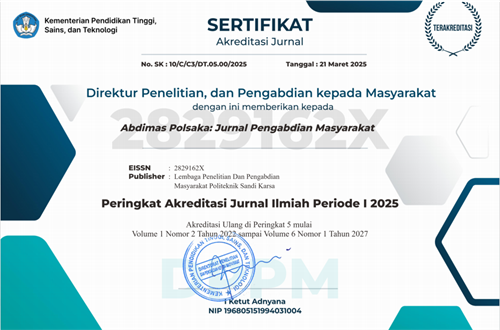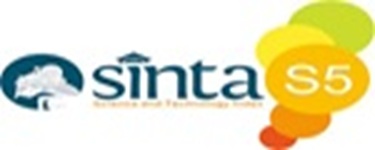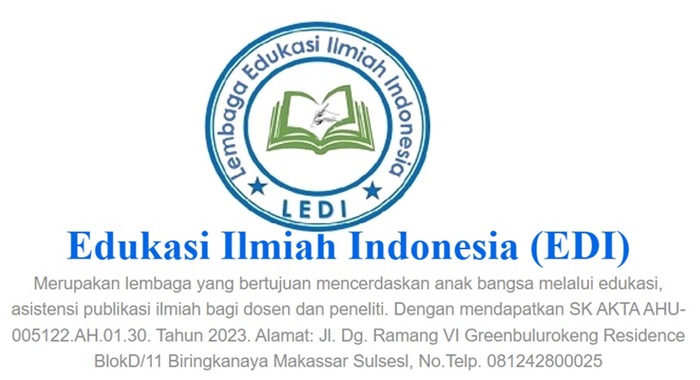Rational education on the use of drugs and self-examination of cholesterol levels for the people of Makassar City
DOI:
https://doi.org/10.35816/abdimaspolsaka.v4i2.98Keywords:
Cholesterol, community service, health education, Point of Care TestingAbstract
Health problems due to high cholesterol levels in the blood are a big challenge for the people of Indonesia, especially in urban areas such as Makassar. High cholesterol is closely related to an increased risk of cardiovascular disease, stroke, and other metabolic complications. On the other hand, the public's understanding of the rational use of drugs is still limited, so it has the potential to cause side effects, drug resistance, and decreased therapy effectiveness. The method of implementing the activity consisted of educational counselling related to the classification of drugs, how to use, store, and dispose of drugs correctly, as well as demonstrations of the use of cholesterol checkers (Easy Touch) using the Point of Care Testing (POCT) method. In addition, participants were given insight into the risk factors for high cholesterol and their control strategies, such as a healthy diet, exercise, and regular check-ups. The results of the activity showed high enthusiasm and participation of participants in the discussion and practice sessions. Brief evaluations through question-and-answer methods indicated an increase in participants' understanding of the importance of rational use of medication and initial skills in independent cholesterol examination. This activity not only fosters health awareness but also strengthens the function of the Tri Dharma of Higher Education in community service. Thus, this activity contributes to increasing public health literacy and encouraging the implementation of a healthy lifestyle to reduce the prevalence of non-communicable diseases in urban areas.
Downloads
References
Ardissone, A. (2024). “In such a dark period, the only light”: Patients’ motivations and strategies to seek care from an online health community during the COVID-19 pandemic. SSM - Qualitative Research in Health, 5, 100425. https://doi.org/10.1016/j.ssmqr.2024.100425
Chen, Z., Cheang, I., Qu, Q., Zhu, X., Fu, Y., Gao, R., Zhou, Y., & Li, X. (2025). Associations of serum uric acid-to-high density lipoprotein cholesterol ratio with age-related diseases and mortality among older population in the United States. Archives of Gerontology and Geriatrics, 130, 105707. https://doi.org/10.1016/j.archger.2024.105707
Darden, M. E., & Papageorge, N. W. (2024). Rational self-medication. Economics & Human Biology, 53, 101350. https://doi.org/10.1016/j.ehb.2024.101350
Gadhave, D. G., Sugandhi, V. V, & Kokare, C. R. (2024). Potential biomaterials and experimental animal models for inventing new drug delivery approaches in the neurodegenerative disorder: Multiple sclerosis. Brain Research, 1822, 148674. https://doi.org/10.1016/j.brainres.2023.148674
Geng, W.-C., Jiang, Z.-T., Chen, S.-L., & Guo, D.-S. (2024). Supramolecular interaction in the action of drug delivery systems. Chemical Science, 15(21), 7811–7823. https://doi.org/10.1039/D3SC04585D
Hong, S., Piao, J., Hu, J., Liu, X., Xu, J., Mao, H., Piao, J., & Piao, M. G. (2025). Advances in cell-penetrating peptide-based nose-to-brain drug delivery systems. International Journal of Pharmaceutics, 678, 125598. https://doi.org/10.1016/j.ijpharm.2025.125598
Husen, F., Ratnaningtyas, N. I., Hidayah Khasanah, N. A., & Yuniati, N. I. (2022). Peningkatan Kadar Kolesterol dan Usia Pada Ibu Rumah Tangga. Jurnal Ilmiah Kesehatan Sandi Husada, 11(2 SE-Articles), 351–359. https://doi.org/10.35816/jiskh.v11i2.775
Kadang, Y., & Megawati, M. (2024). Physical quality test of jamblang fruit ethanol extract antioxidant cream (syzygium cumini (l.) Skeels). Jurnal Ilmiah Kesehatan Sandi Husada, 13(2), 205–213. https://doi.org/10.35816/jiskh.v13i2.1204
Kaundal, R., & Kumar, D. (2025). Current demands for standardization of Indian medicinal plants: A critical review. Medicine in Drug Discovery, 27, 100211. https://doi.org/10.1016/j.medidd.2025.100211
Lei, Z., Jin, M., Lei, Y., Cheng, D., & Sun, T. (2025). Neuraminidase and pH responsive nano-drug against resistant Glaesserella parasuis. International Journal of Biological Macromolecules, 303, 140633. https://doi.org/10.1016/j.ijbiomac.2025.140633
Lin, Y., Yang, R., Li, J., Shao, S., Shi, X., Huang, Z., Zhang, S., Liu, F., Zhang, Y., Zhang, S., Zhang, S., Wen, T., & Tao, H. (2025). MOTS-c-modified functional self-assembly peptide hydrogels enhance the activity of nucleus pulposus-derived mesenchymal stem cells of intervertebral disc degeneration. Materials Today Bio, 32, 101872. https://doi.org/10.1016/j.mtbio.2025.101872
Peddapalli, H., Radha, G. V., & Chinnaiyan, S. K. (2024). Formulation optimization and PK/PD evaluation of novel valsartan bilosomes enhancing transdermal drug delivery. Journal of Drug Delivery Science and Technology, 92, 105400. https://doi.org/10.1016/j.jddst.2024.105400
Suprapto. (2024). Keperawatan kesehatan masyarakat dan homecare : pendekatan terintegrasi untuk pelayanan kesehatan komunitas. LP2M Akademi Keperawatan Sandi Karsa. https://jurnal.edi.or.id/index.php/bci/article/view/73
Suprapto, S., Arda, D., & Kurni Menga, M. (2024). Community empowerment in an effort towards quality health. Jurnal Pengabdian Masyarakat Edukasi Indonesia, 1(2), 49–55. https://doi.org/10.61099/jpmei.v1i2.40
Verma, R., Kumar, K., Bhatt, S., Yadav, M., Kumar, M., Tagde, P., Rajinikanth, P. S., Tiwari, A., Tiwari, V., Nagpal, D., Mittal, V., & Kaushik, D. (2025). Untangling Breast Cancer: Trailing Towards Nanoformulations-based Drug Development. Recent Patents on Nanotechnology, 19(1), 76–98. https://doi.org/10.2174/1872210517666230731091046
Wijayanti, Y. T., Nurhanifah, D., Asmi, A. S., Suprapto, S., Rahagia, R., & Millati, R. (2025). Perception of Nursing Students on Clinical Teaching and Learning of Public Health Nurses: A Descriptive Qualitative Approach. Malaysian Journal of Nursing, 16(04), 142–151. https://doi.org/10.31674/mjn.2025.v16i04.014
Wijayanti, Y. T., Tira, D. S., Lontaan, A., Suprapto, S., & Montolalu, A. (2024). Optimizing the health of the elderly through screening and health education. Abdimas Polsaka, 3(2), 75–82. https://doi.org/10.35816/abdimaspolsaka.v3i2.75
Xiao, H., Liu, J., Huang, M., Zang, W., Zhang, B., Zheng, S., Li, X., He, Z., Wang, X., Ding, H., Li, L., & Sun, B. (2025). Optimizing the stable doxorubicin prodrug nanocomplex for efficient and selective cancer therapy. Chemical Engineering Journal, 504, 158945. https://doi.org/10.1016/j.cej.2024.158945
Zeng, W., Deng, H., Luo, Y., Zhong, S., Huang, M., & Tomlinson, B. (2024). Advances in statin adverse reactions and the potential mechanisms: A systematic review. Journal of Advanced Research. https://doi.org/10.1016/j.jare.2024.12.020
Zhang, B., Liu, W., Liu, J., Huang, M., Li, Y., Zhao, E., Zhang, L., Shi, X., Sun, J., He, Z., Li, L., & Sun, B. (2024). Rational engineering of cholesterol-modified prodrug nanoassemblies for improving the tumor selectivity and safety of mitoxantrone. Fundamental Research. https://doi.org/10.1016/j.fmre.2024.06.006
Zhang, Z., Yang, J., Liu, R., Ma, J., Wang, K., Wang, X., & Tang, N. (2024). Inhibiting HMGCR represses stemness and metastasis of hepatocellular carcinoma via Hedgehog signaling. Genes & Diseases, 11(5), 101285. https://doi.org/10.1016/j.gendis.2024.101285
Zhu, Q., Wang, Y., Wang, L., & Su, G. (2024). Elucidating acceptance and clinical indications to support the rational design of drug-eluting contact lenses. International Journal of Pharmaceutics, 665, 124702. https://doi.org/10.1016/j.ijpharm.2024.124702

Additional Files
Published
How to Cite
Issue
Section
License
Copyright (c) 2025 Yuniharce Kadang, Zulfiah Zulfiah

This work is licensed under a Creative Commons Attribution 4.0 International License.
Most read articles by the same author(s)
- Sulfiyana H. Ambo Lau, Herman Herman, Zulfiah Zulfiah, Counseling on the Use of Lime (Citrus aurantifolia) as Pharmaceutical Preparations in the Making of Mouthwash and hand Sanitizer , Abdimas Polsaka: Vol. 2 No. 2 (2023): Abdimas Polsaka: Jurnal Pengabdian Masyarakat




















